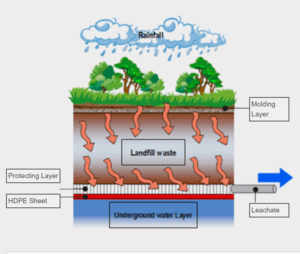
The engineering team presents a pilot-scale treatment design for the leachate of the Tillamook County Landfill (TCL). The current leachate management system of spray irrigation on a land application area has been deemed unsustainable and requires redesign. The Department of Solid Waste Prevention and Recycling of the Tillamook County Public Works Department is looking to apply a passive treatment process to facilitate leachate discharge to a vegetated swale. National Pollutant Discharge Elimination System (NPDES) permitting requires iron and ammonia concentrations to be reduced in the leachate. Iron and ammonia concentrations need to be below the monthly maximums of 0.95 mg/L and 3 mg/L, respectively. The permit also includes limits on pH (6.5 - 8.5) and total suspended solids (<100 mg/L). The site is limited in area with 0.1 acres allotted for pilot-scale application and 0.8 acres for full-scale. There is high variability in leachate flow rates due to seasonal changes. The client has requested a design that is operable year-round.
A treatment alternatives analysis was completed separately for iron and ammonia removal processes. Alternatives were selected using a decision matrix consisting of primary and secondary criteria. The primary criteria focused on project constraints that were nonnegotiable. They included permit limits, area constraints, scalability, and safety. The client’s desired system qualities influenced secondary criteria. They considered passive treatment, cost, longevity, operability, and ability to use local supplies in the project. Criteria weighting was based on category and client emphasis. A rating scale of -5 to 5 was used to designate how the alternative met or did not meet the design criteria. Through this process, the pilot-scale design was determined.
The pilot-scale design consists of a stepped cascade aerator with a sedimentation basin for iron treatment and vertical flow constructed wetlands (VFCW) for ammonia treatment. The stepped cascade aerator is 9.84’ in height, 11.9’ in length and 4.96” in width, taking a total area of 0.0001 acres. The sedimentation basin is 9.52’ in length, 2.13’ in width and 1.64’ in depth, taking a total area of 0.0005 acres. The basin has a retention time of 24 minutes and is designed with a launder v-notched weir for effluent management. The VFCW system consists of two series of four wetland cells in parallel. Each cell is 25’ in length, 5.9’ in width and 2’ in depth. The cells are layered from top to bottom with 1” of gravel, 1’10” of well-graded sand as the substrate medium and 2” of gravel for drainage. The VFCW system takes up a total of 0.027 acres. The total area required for the pilot-scale design is 0.0276 acres.
The engineering team designed the pilot-scale system to verify assumptions through pilot-scale testing prior to full-scale application. The pilot-scale application will be used to evaluate system efficiency through metrics of aeration, iron removal, sludge removal, nitrification, and ammonia removal. Verifying these assumptions through pilot-scale testing will lead to a more reliable, robust full-scale system. Full-scale sizing and process flow was considered throughout the design to ensure it was scalable within the area constraints. Scale-up calculations provided an estimate for full scale application. The projected area requirement for the full-scale design is 0.64 acres. The design includes two stepped cascade aerators, two sedimentation basins, and four series of four wetland cells in parallel for treatment redundancy.
| Attachment | Size |
|---|---|
| 587.63 KB | |
| 265.46 KB | |
| 403.32 KB |

